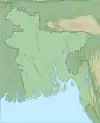Satchari National Park
Satchari National Park (Bengali: সাতছড়ি) is a national park in Habiganj District, Bangladesh. After the 1974 Wild Life Preservation Act, in 2005[2] Satchari National Park was built on 243 hectares (600 acres)[2] of land. Literally 'Satchari' in Bengali means 'Seven Streams'. There are seven streams flowing in this jungle, and the name 'Satchari' came from there.[2]
| Satchari National Park | |
|---|---|
IUCN category II (national park) | |
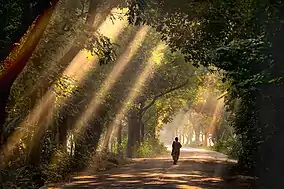 | |
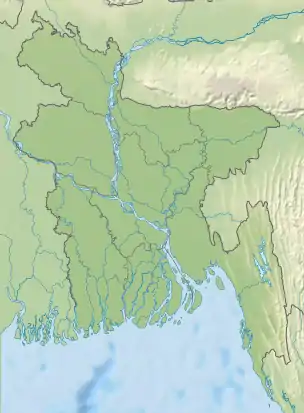 Map of Bangladesh | |
| Location | Habiganj District, Bangladesh |
| Coordinates | 24°07′12″N 91°27′03″E[1] |
| Area | 243 ha (600 acres) |
| Established | 2005 |
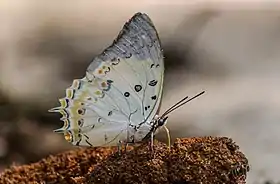
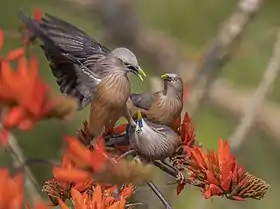
Details
The park is situated in Raghunandan hill, under Paikpara Union, Chunarughat Upazila, Habiganj District, under Sylhet region.[3] It is 130 kilometres (81 mi) from the capital city of Bangladesh, Dhaka. There are 9 tea gardens nearby. Satchari tea garden is on the West and Chaklapunji tea garden is on the East. Approximately 24 families of Tipra Tribe are living now (2007) in the Tipra village.
Plants
There are approximately 200 and more trees are in Satchari National Park. Shaal (Shorea robusta), Segun (Tectona grandis), Agar, Garjan, Chapalish, Palm, Mehgani, Krishnachur, Dumur (Ficus), Jamrul, Shidha Jarul, Awal, Malekas, Eucalyptus, Akashmoni, Bamboo trees, bet trees (regional name Mutra) are the most common species of trees found there.[4]
Wildlife
Wildlife in this park is rich. Red junglefowl, red-headed trogon, Oriental pied hornbill and pygmy woodpecker are some of them. The critically endangered hoolock gibbon also resides here. Also Phayre's leaf monkey, a species of langur also resides here.[3] Asian black bears also reside here in small numbers.
Nisharga Shahayata Prakalpa
Beside the National Forest Department, an NGO named "Nisharga", with their "Nisharga Shahayata Prakalpa", observes the park. Beside the preserving forest they provide eco-tours. The NGO also sells some fancy items there.[4]
See also
| Wikimedia Commons has media related to Satchari National Park. |
Notes
- "Satchari National Park". protectedplanet.net.
- Ridwan Akram (25 January 2010). "Bone Jongole". The Daily Kaler Kantho (Print) (in Bengali). Dhaka. p. 9.
- "Satchari National Park". World Wildlife Adventures. 16 January 2011.
- Fakhrul Alam (16 August 2010). "Hatchhani diye dakchhe Satchari National Park". Amar Jeebon, The Daily Amar Desh (Print) (in Bengali). Dhaka. p. 6.
Further reading
- Whyte, Mariam; Yong, Jui Lin (2009). Bangladesh. Marshall Cavendish. p. 60. ISBN 978-0-7614-4475-6.
- Leung, Mikey; Meggitt, Belinda (2012). Bradt Travel Guide - Bangladesh. Bradt Travel Guides. p. 217. ISBN 978-1-84162-409-9.
- "Satchari National Park". Lonely Planet.
- Mukul, Sharif Ahmed; Uddin, Mohammad Belal; Tito, Mashiur Rahman (2007). "Medicinal Plant Diversity and Local Healthcare Among the People Living in and Around a Conservation Area of Northern Bangladesh". Int. J. For. Usuf. MNGT. 8 (2): 50–63. ISSN 0972-3927.
- Uddin, Mohammed Belal; Mukul, Sharif Ahmed (2007). "Improving Forest Dependent Livelihoods Through NTFPs and Home Gardens: A Case Study from Satchari National Park" (PDF). Making Conservation Work:Linking Rural Livelihoods and Protected Areas in Bangladesh. pp. 13–35.
- Arefin, Md Kamrul; Rahman, Md Mizanur; Uddin, Mohammad Zashim; Hassan, Md Abul (December 2011). "Angiosperm Flora of Satchari National Park, Habiganj, Bangladesh". Bangladesh J. Plant Taxon. 18 (2): 117–140. doi:10.3329/bjpt.v18i2.9298.
- Mukul, Sharif Ahmed; Rashid, A.Z.M. Manzoor; Quazi, Shimona A; Uddin, Mohammed Belal; Fox, Jefferson (2012). "Local peoples' responses to co-management regime in protected areas: A case study from Satchari National Park, Bangladesh". Forests, Trees and Livelihoods. 21 (1): 16–29. doi:10.1080/14728028.2012.669132. S2CID 167724822.
- Chowdhury, Mohammad Shaheed Hossain (2014). Forest conservation in protected areas of Bangladesh: Policy and community development perspectives. Springer. ISBN 978-3-319-08147-2.
- Chowdhury, Abida Rahman (9 November 2015). "Plan your day trip adventure". The Daily Star.
